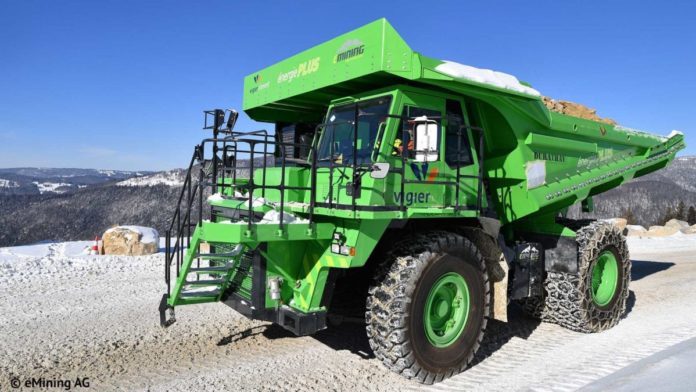Our esteemed chairman, in his August leader column on this very site, bemoaned some of the difficulties associated with charging today’s electric vehicles.
Well, one seemingly unlikely answer to this irritating and increasingly relevant issue is out there, and has just started work. Mind you, our chairman might have to move to the top of a Welsh mountain to put it to good use, and could have some difficulty accommodating the prototype on his drive.
This is a story that’s as Swiss as Gruyère cheese and Zurich gnomes – and about as far removed as its possible to get from a cuckoo clock, which, together with precision-designed watches, are arguably some of the earliest and best-known icons of Swiss mechanical ingenuity.

It’s perhaps not quite so well known that Switzerland also claims a lengthy career in the building of special-purpose vehicles, including rare but skilfully designed and sometimes obscure machinery ranging from aerial cableways to wheeled agricultural and military products – and much more.
Back in 2016, a group of Swiss engineers from a consortium headed by Lommis- based Kuhn-Schweiz AG, who happen to be European distributors for Komatsu Dumper Trucks, alighted on an unsuspecting and already well used example of this breed. It had spent its first life working hard around the quarry of a cement works operated by Ciments Vigier SA, some 50km from Bern.
Like its compatriots used in earthmoving and similar heavy industries worldwide, it was powered by a diesel engine, matched to the demands of its, ahem, considerable carrying capacity. This was a rather large dumper truck – standing 4.4 meters tall, 9.36 metres long, and 4.24 metres wide, built on a 4.3 metre wheelbase… with an unladen weight of 45 tonnes, and a 65 tonne payload.
These trucks – routinely running at gross weights near 110 tonnes – can be a bit heavy on both fuel and emissions: typical diesel consumption is estimated at around 83,000 litres a year per vehicle, accompanied by the despatch of a nightmarish-sounding 200 tonnes of Co2 into the atmosphere.

A fully laden downhill run at such gross weights also tends to warm up the brakes a bit, wasting lots of valuable energy. These characteristics made this ageing vehicle the ideal starting point in a bold bid to engineer a culture-shift of epic proportions in really heavy load carrying – by creating the largest battery powered vehicle in the world…AND one that never needs recharging….
Over the last two years the diesel powertrain has been removed, and the vehicle adapted to accommodate battery packs weighing over 4 tons with 700kWh total capacity – mounted in some unlikely places on the chassis. This was followed by painstaking reassembly to incorporate a prototype all-electric drivetrain, with specially designed control equipment.
Naturally its been topped off with a paint job, the previous “any colour you like as long as its eternally familiar construction plant yellow” now replaced by a suitable shade of eco-green.
The plan is to run the vehicle in this form for up to ten years, transporting 60 tonnes of lime and marl twenty times a day from a quarry on the upper slopes of the Chasseral mountains, down to a cement works near Biel in the valley below.
In doing so, the venture is pursuing that eternal holy grail of energy for nothing – with 10% extra, also free, left over to put to good use – all delivered in particularly demanding, unusual and indeed near-unique circumstances.
Based on the nowadays quite familiar principle used in electric cars, but on a vastly bigger scale, the powerful electric motors needed to propel the fully laden vehicle will provide massive energy recovery from regenerative braking when travelling downhill.
The electrical system has been designed to ensure that a fully laden descent will, on its own, completely recharge the battery pack – removing any need for a handy but slow mountain-top recharge point, or any associated time delay.
The resulting charge is calculated to not only power the empty 45 tonne truck merrily back up the hill to collect the next load and repeat the process… but also leave useful surplus capacity in hand – electricity saved from each circuit which can ultimately be fed back into the local grid.
The on-board systems have been designed to allow the vehicle to cope with inclines of up to 13%, working entirely off road in tough environmental conditions, while coping with wide temperature variations which can significantly affect battery capacity.
RECHARGING ENERGY IDEA – As part of the South Wales Mineral Railway in 1850, Isambard Kingdom Brunel decided to link the collieries at Glyncorrwg in the Afan Valley with the Docks at Briton Ferry. He constructed The Incline above Briton Ferry and used a steel hawser to permit laden coal wagons to descend and their weight was utilised to pull up empty wagons for refilling, before the line closed in 1910.
The practicalities of engineering for reliability and incorporating comprehensive safety measures given the electrical loads and prodigious battery capacity involved have been a particular design challenge, with battery discharge currents apparently reaching 3,000 amps, alongside peak charging rates of up to 40 kWh during descents.
Though the concept might appear to have all the elusive qualities of a perpetual motion machine, Ciments Vigier SA has reportedly already invested the equivalent of almost £1M in the project, and the seriousness of the venture is underlined by the involvement of two Swiss universities, several major specialist companies, the Swiss Federal Office of Energy, and the Kuhn Group itself.
If the truck proves successful and sufficiently reliable in this most demanding of electric vehicle applications to date, Ciments Vigier says it sees potential long term use for up to eight such vehicles. Komatsu distributor Kuhn Schweiz believes successful trials could open up untapped market potential for such vehicles, especially on sites where sensitivity to exhaust emissions or noise are major concerns.
© Dave Moss | More on this: eMining video
Dave Moss has a lifetime connection with the world of motoring. His father was a time-served skilled engineer from an age when car repairs really meant repairs: he ran his own garage from the 1930’s to the 60’s, while Mum was the boss’s secretary at a big Austin distributor. Both worked their entire lives in the motor trade, so if motor oil’s not in Dave’s blood, its surely a very close thing.
Though qualified in Electronics, for Dave it seemed a natural step into restoring a succession of classic cars, culminating in a variety of Minis. Writing and broadcasting about these, and a widening range of motoring matters ancient and modern, gathered pace in the 1970’s and has taken over since. Topics nowadays range across the modern motoring mainstream to the offbeat and more arcane aspects of motoring history, and outlets embrace books, websites national and international magazines, newspapers, radio programmes, phone-ins and guest appearances. Spare time: hard graft on the garage floor attending to vehicles old and new. Latest projects: that 1968 Mini Cooper S has finally moved again after 30 years, and when the paint is finished, the 1960 Morris Mini 850 will also soon be ready for the road again…






